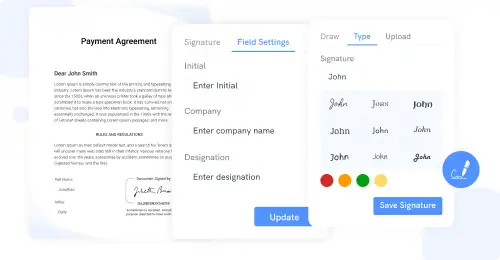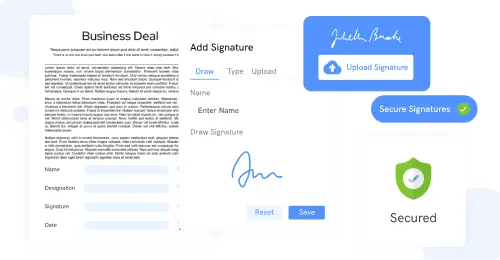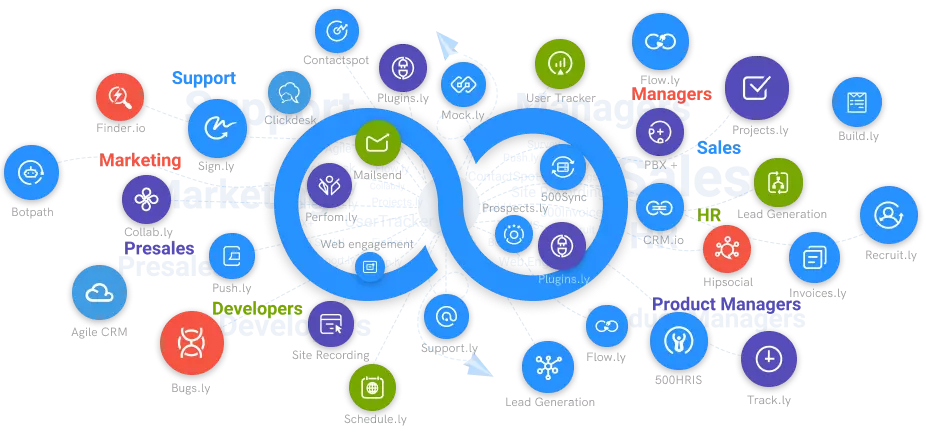What are the 5 Things Every SME Should Know About eSignature?
Lets find in detail what are the 5 things every small and medium-sized business should know about electronic signatures
#1
Get digital signatures on documents like sales contracts, employee HR letters, and more
#2
Create components like signature, date, initials on document via drag and drop builder
#3
Enable multi-party signing and share documents to multiple users
#4
Choose from 15+ scenario based pre-designed templates
#5
Upload documents from your local system or cloud providers like Dropbox, Google Drive and 500Box
#6
Track individual signee status for each document
#7
Send documents for signature from your favorite CRM software like CRM.io
#8
Set a hierarchical order for signing documents
#9
Unbelievable pricing - the lowest you will ever find
#10
Everything your business needs - 50 apps, 24/5 support and 99.95% uptime
Despite living in a digitally-driven world, manual printing, wet ink signing, scanning, and faxing are still used in 80 percent of corporate document operations. These paper-based practices not only stymie productivity efficiency but may also harm your brand and customer experience.
According to a recent study, more than 37% of SME leaders are dealing with issues connected to agreements that were signed by the wrong person or that were not fully finished. Electronic signatures are one of the most widely used digital technologies, providing SMEs with a straightforward answer to these long-standing issues.
However, most SMEs struggle to obtain the answers they require during the early phases of electronic signature research. Is the authenticity of these signatures guaranteed? Are they legal in every state in the United States? What sorts of industry-specific documents are supported by electronic signatures? The sooner you learn the fundamentals, the sooner you can begin using your newly established electronic signature system.
1. Digital Signatures and Electronic Signatures are Not the Same Things
Although the phrases electronic signature and digital signature are sometimes used interchangeably, they are not interchangeable. An electronic signature is a digital version of a handwritten signature that businesses may use to express their desire to approve or accept the content of a document.
Digital signature online, on the other hand, are a type of electronic signature that uses algorithms to produce a unique fingerprint (sometimes known as a "hash") for each document. This hash can be used to identify the individual who signed the document.
One thing to remember is that, while electronic and digital signatures may be used to lawfully sign papers, SMEs should first grasp the local rules that apply to their case before deciding between the two ways.
2. Electronic Signatures are Legally Equivalent to Wet Ink Signatures
Electronic signatures are a type of signature that is recognized by the federal government. The United States' ESIGN Law (Electronic Signatures in National and Global Commerce) and the European Union's eIDAS Regulation (Electronic Identification, Authentication, and Trust Services). Avoid rejecting an electronically signed document's legal impact, validity, or enforceability merely because it is in electronic format.
Today, more than 60 nations have established their own set of laws and standards that accept electronic signatures, making them legitimate and enforceable in a court of law, provided that the procedures are developed and implemented in line with the requirements of the law.

3. Electronic Signatures are Allowed in Every State in the United States
Electronic signatures are allowed in all 50 states, contrary to common perception. This confusion stems largely from the fact that another piece of securing information by eSignature software, the UETA (Uniform Electronic Transactions Act), has only been enacted by 47 states, the District of Columbia, Puerto Rico, and the United States Virgin Islands. Most people overlook the fact that, while Illinois, New York, and Washington have not embraced UETA, they have enacted comparable legislation to confirm the validity of electronic signatures. Furthermore, the federal government adopted the ESIGN. Act enacted in 2000 allowing electronic signatures the same legitimacy as wet ink signatures throughout the United States.
4. Electronic Signatures are Legal in Most Sectors for Most Sorts of Documents
While proposals, trade agreements, sales contracts, and nearly any other form of agreement can be signed electronically, most electronic signature laws across the world include a few significant limitations. For example, the ESIGN Act and the UETA both remove property transactions, wills, and other legal notices from the list of papers that can be signed electronically. Similarly, agreements relating to powers of attorney, wills, and real estate transactions are excluded under India's Information Technology Act (Information Technology Act).
5. Implementing Electronic Signatures Does Not Need Any Technical Knowledge
It is simple to include electronic document signing technology in your process. Most electronic signature solutions now have built-in integration features, allowing SMBs to utilize them with their favorite apps such as Zoho, Outlook, Office 365, and others.

Conclusion
This way, your workers can quickly set up workflows in their preferred business apps and go back to work. According to a recent study, 45 percent of SME executives believe that eSignature online can boost staff productivity.
Also, while selecting electronic signature software, seek one that has an easy-to-use interface. You may get your equipment up and running in minutes this way.





